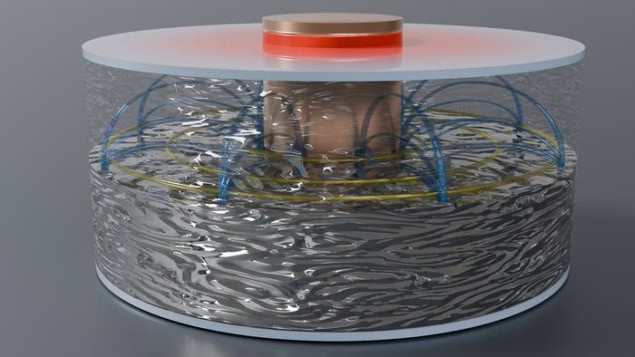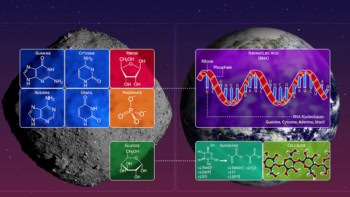
The thermoelectric effect is much stronger at the interface of two liquid metals than it is in solid–solid or solid–liquid systems. This discovery, from researchers at the Ecole Normale Supérieure (ENS) in Paris, France, could lead to improvements in batteries that contain liquid–metal interfaces, and might even enhance our understanding of Jupiter’s magnetic field.
In thermoelectric materials, the flow of heat from a cooler area to a warmer one can be harnessed to generate electricity via the thermoelectric effect, which converts temperature differences into an electric voltage. The effect is usually seen at solid interfaces between electrical conductors or semiconductors or between solids and liquids.
“Some very unusual behaviours”
In the latest work, however, a team led by ENS physicist Christophe Gissinger observed a thermoelectric effect between two metals, gallium and mercury, that are both liquids at 30 °C.
“The liquid–liquid nature of the interface between the two metals leads to some very unusual behaviours,” Gissinger explains. “First, the electric currents generated in our liquid experiment are 50 to 100 times more intense than expected in conventional solid systems. Second, the geometry of these currents is complex, featuring multiple loops and stagnation points, which have no equivalent in solid thermoelectricity.”
The researchers also found that when they applied a magnetic field to the interface, the field interacted with the thermoelectric current in a way that made the two liquids rotate in a circular pattern, but in opposite directions, at a speed of a few centimetres per second. This effect, which can be observed with the naked eye, could lead to a new way of pumping these liquids.
Experimental challenges
To perform the measurements, the team had to overcome two challenges. The first, says Gissinger, was controlling the temperature of the system. “For a convincing quantitative study, we needed a very large temperature gradient, of around 80°, but to a precision of less 0.3°, which required a powerful cooling/heating system,” Gissinger says.
The second challenge was measuring the thermoelectric effect. At just a few microvolts, the voltages the researchers measured were too low for conventional probes. This meant the team needed to create a new type of probe and perform a great deal of signal acquisition and processing on the experimental data. “Using metals that are liquid at room temperature was key because it greatly facilitated the installation of these elements,” Gissinger says.
From planets to batteries
As for practical implications of the discovery, Gissinger notes that the interior of the planet Jupiter also contains a liquid-liquid interface, between molecular hydrogen and metallic hydrogen. “Since the poles and the equator are generally not at the same temperature, you have here a configuration that is quite similar to the set-up in our experiment: a temperature gradient along an interface between two different conducting liquids,” Gissinger tells Physics World. “A thermoelectric current is generated at the interface between these two liquids that could interact with the planet’s radial magnetic field to generate complex zonal flows.”

Inexpensive thermoelectric material works at room temperature
The work could also lead to improvements in liquid metal batteries, which Gissinger describes as a highly promising technology for energy storage. These devices are similar to conventional batteries except that the anode and cathode are made from liquid metals separated by a liquid electrolyte. They are therefore based on a superposition of conducting fluids, similar to those described in the ENS study. “We expect that by maintaining a temperature difference in different parts of the battery, a strong thermoelectric current will appear around its liquid interfaces,” Gissinger says. “With an appropriate applied magnetic field, we can thus agitate the electrodes (by thermoelectric pumping) and enhance the battery’s efficiency.”
The researchers, who report their work in PNAS, say they would now like to see whether they can amplify the new thermoelectric effect by trying out other types of conducting fluids.



